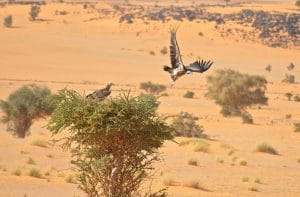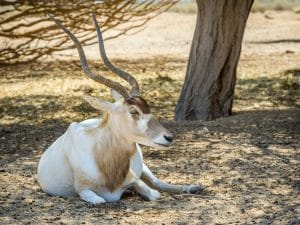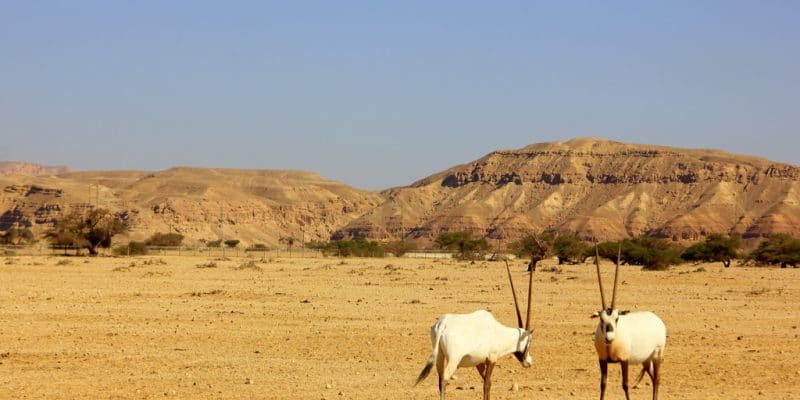The Government of Niger has decided to declassify part of the Termit and Tin-Toumma National Nature Reserve (RNNTT) in favour of an oil exploitation activity by the China National Petroleum Corporation (CNPC).
Preserving biodiversity in the midst of a desert environment was the challenge faced by the French non-governmental organisation (NGO) Noé, which obtained delegated management of the Termit and Tin-Toumma National Nature Reserve (RNNTT). The NGO has recently raised the alarm following the decision of the Nigerian authorities to declassify part of the reserve for oil exploitation. The RNNTT is a natural area located in eastern Niger.
A few plants manage to grow in this desert space, and it’s enough to support many herbivorous species such as the dama gazelle and the dorcas gazelle that can only be found in this part of the world. The RNNTT also offers the opportunity to observe the parades of the cuffed sheep, a close family member of the goat. However, the main animal of this region is undoubtedly the addax, a species of antelope recognisable by its white coat, which distinguishes it from the reddish colour of the desert. An animal in very high danger of extinction.

Vultures in the Termit and Tin-Toumma reserve©Sébastien Pinchon/Noé
All these herbivores must remain vigilant not to end up in the maw of the Sahelian cheetah, which has the necessary camouflage to fade into a treeless landscape. The RNNTT is also overflown by the white-throated bee-eater, which enjoys the insects that manage to survive in this desert environment.
The threat of oil exploitation
The Termit and Tin-Toumma reserve is one of the largest on the African continent, with an area of nearly 100,000 km2, almost four times the size of Rwanda. Experts already knew it was threatened by an oil field, since China National Petroleum Corporation (CNPC) has been operating wells in the region for several years.
The situation has changed recently with the decision of the Government of Niger to declassify a large part of the Tin-Toumma area. This decision comes at a time when, according to the NGO Noé, the Chinese giant CNPC already exploits 21 wells within the reserve. This oil is evacuated via a pipeline that crosses the reserve for 100 km to the refinery in the town of Zinder.
Consequences for the reserve
Human activity will undoubtedly disturb the tranquillity of animals, especially addax, which are naturally fearful. In addition, the presence of humans around the reserve increases the risk of poaching the endangered species. “There are three groups of addax in the Termit and Tin-Toumma reserve. They occupy a space of between 5,000 km and 6,000 km. If oil exploitation increases, they will seek refuge elsewhere. But the problem is that within the Termit and Tin-Toumma reserve, the habitat favourable to addax is the eastern slope of the massif where they can take refuge under the acacias during the great hot season. They go back to Tin-Toumma where they have grazing and a good knowledge of the land. When they leave the reserve, they could find themselves in an environment where protection is very limited. In the long term, if they have to leave Tin-Toumma, they are doomed,” says Sebastin Pichon, head of the NGO Noé.

An addax sheltering from the sun in the Termit and Tin-Toumma©Sergei25/Shutterstock reserve
The Nigerian government seems to be aware of the situation. Niger signed a production sharing contract on June 2, 2008 with the CNPC, which stipulates in its article 36.9 that “the contractual zone does not contain any perimeter subject to classification or special protection, at the national or international level; the State will refrain from creating such perimeters on the contractual zones during the duration of the contract”, indicated the Government of Niger at the end of the Council of Ministers on June 26, 2019.
He also states that “the Termit and Tin-Toumma reserve will keep the same area of 96,560 km2, but the boundaries will be moved to the western and northern municipalities, particularly to the Aderbisnat, Tenhia, Tchirozérine, Tabelot and Timia localities”.
According to Sébastien Pichon, the areas proposed by the government do not represent any challenge for biodiversity. “The western part concentrates human activities. This is essentially livestock farming. In addition, the city of Agadez would be on the periphery of the reserve,” says Noé’s manager. The NGO proposes to set up with the CNPC “environmental and social measures and compensation mechanisms that meet international standards”.
Jean Marie Takouleu








You must be logged in to post a comment.